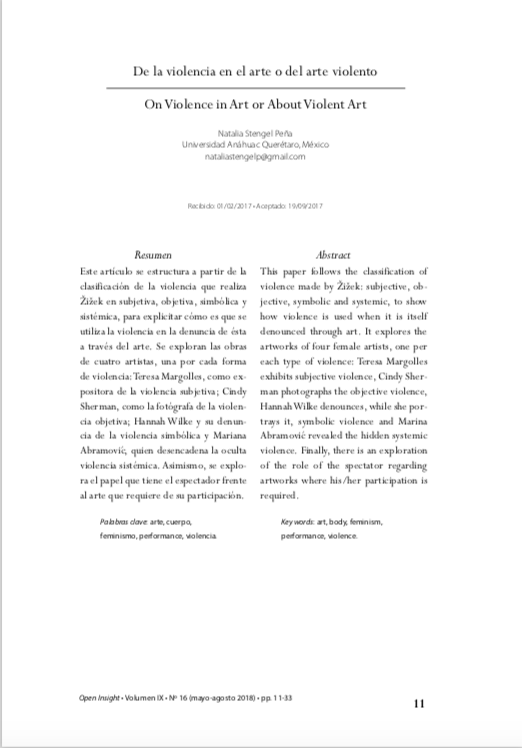On Violence in Art or About Violent Art
Abstract
The feminists of the Second Wave found in art a public sphere in which they were allowed to express freely. They took advantage of this new freedom to denounce the violent situation in which women lived, and still live. Some of the first feminist artworks from the seventies, like Dinner Party (1974-1979), Rhythm 0 (1974), Intra Venus (1993) or the collective exhibition Womanhouse (1972) commonly used violence to express violence. This rose a debate about the validity of this art. Nevertheless, nowadays performance is frequently seen in museums, and it does not strive for validation anymore. This paper follows the classification of violence made by Žižek: subjective, objective, symbolic and systemic, to show how violence is used when it is itself denounced through art. It explores the artworks of four female artists, one per each type of violence: Teresa Margolles exhibits subjective violence, Cindy Sherman photographs the objective violence, Hannah Wilke denounces, while she portrays it, symbolic violence and Marina Abramović revealed the hidden systemic violence. Finally, there is an exploration of the role of the spectator regarding artworks where his/her participation is required.References
Barthes, R. (1986). Lo Obvio y lo obtuso, Fernández Medrano, C.,trad. Barcelona: Paidós.
Baudrillard, J. (1978). Cultura y simulacro. Rovira, P., trad. Barcelona: Editorial Kairós.
Baudrillard, J. (1991). La transparencia del mal. Jordá, J. Barcelona: Anagrama.
Baudrillard, J. (1995) El crimen perfecto. J. Jordá, trad. Barcelona: Anagrama.
Beauvoir, S. de (2010). El Segundo Sexo. Barcelona: De Bolsillo.
Bray, R. S. (2011). “Teresa Margolles's Crime Scene Aesthetics”. South Atlantic Quarterly, 110(4): 933-948.
Bauman, Z. (2004). La sociedad sitiada. Rosenberg, M.; E. Zaidenwerg, trads. Buenos Aires: Fondo de Cultura Económica.
Benjamin, W. (2003). La obra de arte en la época de su reproductibilidad técnica. Weikert, A. E.,trad. Cd. de México: Editorial Ítaca.
Espejo, B. (18 de febrero de 2014). “Teresa Margolles: apuesto por un arte vivo y crítico”. El cultural. Disponible en: http://www.elcultural.com/noticias/arte/Teresa-Margolles-Apuesto-por-un-arte-vivo-y-critico/5922 (Fecha de consulta: 23 de octubre de 2017).
Foster, H. (1996). “Death in America”. October, 75.
Foucault, Michel. (2007). Sexualidad y poder, Gabilondo, A., trad. Barcelona: Folio.
García Pérez, N. (2009). La mujer en la publicidad. Salamanca: Universidad de Salamanca.
Galli, J., ed. (1999). Crónica del Siglo XX. Alaminos, F., trad. Barcelona: Ed. Plaza Janés.
Gobrich, E. H. (2011). La historia del arte, ed. 16ª. Santos Torroella, R., trad. Londres; Editorial Phaidon.
Heinberg, L. J.; J. K. Thompson. (1995). “Body Image and Televised Images of Thinness and Attractiveness: A Controlled Laboratory Investigation”. Journal of Social and Clinical Psychology, 14(4).
Jameson, Frederic. (1991). Ensayos sobre posmodernidad. Pérez, E.; C. Ferrer, S. Mazzco, trads. Buenos Aires: Ediciones Imago Mundi.
Jones, A. (2012). “Regresa al cuerpo, el lugar donde se manifiestan todas las escisiones de la cultura occidental”. El cuerpo del artista. Cd. de México: Phaidon.
Kandinsky, W. (2003). Punto y línea sobre el plano. Echavarren, R., trad. Buenos Aires: Editorial Paidós.
Kant, I. (2005). Crítica del juicio, Rovira Armengol, J., trad. Buenos Aires: Losada.
Shinner, L. (2004). La invención de arte. Barcelona: Paidos.
Mendoza Hernández, E.; Navarro Bello, A. (2015). “Van más de 57 mil asesinatos en lo que va del sexenio; gobierno oculta 9 mil: Zeta” Aristegui Noticias. México D.F., 31 de agosto de 2015.
Metrópolis. (10 de marzo de 2014). “Entrevista a Teresa Margolles”. Televisión Española.
Parmesani, L. (2000). Art of the Twentieth Century. Movements, Theories, Schools and Tendencies 1900-2000. Billingsley, R., trad. New York: Skira.
Phelan, P. (2012). Arte y feminismo. Cd. de México: Phaidon.
Bourdieu, P. (2007). La dominación masculina. Barcelona: Anagrama.
Barthes, R. (1986). Lo Obvio y lo obtuso, Fernández Medrano, C.,trad. Barcelona: Paidós.
Segura Cabañero, J. (2010). Teresa Margolles: Necropolíticas de la visión.
Shinner, L. (2004). La invención del arte. ,Hyde,E., E.Julibert, trads. Barcelona: Paidos.
de Beauvoir, S. (2010). El Segundo Sexo. Barcelona: De Bolsillo.
Sontag, S. (1989). AIDS and its metaphors. Londres: Allen Lane.
Taine, H. A. (2000). Filosofía del arte. Cebrián, A., trad. Ediciones El Aleph.
Tembeck, T. (2009) “Exposed Wounds: The Photographic Autopathographies of Hannah Wilke and Jo Spencer”. Revue d'art canadienne/Canadian Art Review, 33(1–2): 87-101.
Walther, I. F., ed. (2012). Arte del siglo XX. Monton, R., trad. China: Taschen.
Warhol, A. (2014). Mi filosofía de A la B y de B a A. Covián, M., trad. Cd, de México: Tusquets.
Warhol, A. (1999). Art in our time: 1950 to the Present. Estados Unidos, Walker Art Center.
Žižek, Slavoj. (1989). The Sublime Object of Ideology. Bristol: The Cromwell Press.
Žižek, Slavoj. (2008). Violence: six sideways reflections. Picador: Nueva York. Edición digital.





